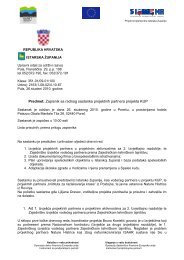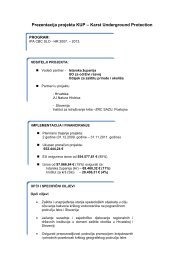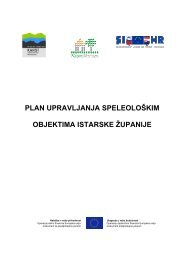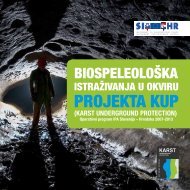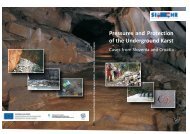prvi hrvatski speleološki kongres - KARST underground protection
prvi hrvatski speleološki kongres - KARST underground protection
prvi hrvatski speleološki kongres - KARST underground protection
Create successful ePaper yourself
Turn your PDF publications into a flip-book with our unique Google optimized e-Paper software.
The History of the speleological explorations in the catchment area of<br />
<strong>underground</strong> rivers Reka and Ljubljanica, West Slovenia<br />
Povijest speleoloških istraţivanja u porječju krških rijeka<br />
Ljubljanica i Reka u zapadnoj Sloveniji<br />
Andrej Mihevc 1<br />
1<br />
Karst Research Institute , Titov trg 2, 6230 Postojna, Slovenia; mihevc@zrc-sazu.si<br />
Key words: podzemne rijeke, Reka, Ljubljanica, krš<br />
Ključne riječi: Underground rivers, Reka, Ljubljanica, Karst<br />
In Western part of Dinaric karst in Slovenia there are two from the point of<br />
history of speleology important karst rivers: river Reka and river Ljubljanica.<br />
Ljubljanica river is formed from a group of springs with discharge of the 38.6<br />
m 3 s -1 at Vrhnika. Main part of the 1000 km 2 large catchment area is in karstified<br />
rocks, with direct karst recharge. Part of the water does appear in springs on the edges<br />
of four poljes, crosses them and sinks again. Part of the water is supplied also by<br />
sinking rivers from noncarbonate rocks.<br />
At springs and sinks several large cave systems were formed. Because of large<br />
cave entrances, sinking rivers, springs and ponors and long lasting floods on the poljes<br />
the area was in the focus of the interest of natural sciences long ago. Karst water<br />
phenomena were first described in 17.th century. A. Kircher is giving <strong>underground</strong><br />
rivers from Cerknica polje as an example for his general theory on hydrophilacia. The<br />
floods were later studied by J.V. Valvasor (1689), who also made some cave<br />
exploration. Karst and caves were explored by F.A. Steinberg (1758), T. Gruber<br />
(1781), and F. Nagel (1754). In 19.th century there is a large increase of the cave<br />
exploration in the area especially after the discovery of the inner part of Postojnska<br />
jama in 1818 (L. Ĉeĉ, J. Jeršinoviĉ, F.H. Hohenwart and F. Schafenrath,) and in<br />
Planinska jama (A. Urbas, A. Schmidl). These explorations were connected with<br />
touristic development and scientific interest in caves, cave biology, paleontology and<br />
archeology (F. Hochstetter, J. Szombathy) in Postojnska jama, Planinska jama and<br />
Kriţna jama. First cave animals were discovered and described. More difficult water<br />
caves and deep pits were explored later in connection to hydro meliorations of karst<br />
poljes (W. Putick).<br />
In the second half of the 19.th speleological societies appeared. In Postojna<br />
between years 1889 – 1905 caving society Anthron, and after year 1910 speleological<br />
society from Ljubljana. After WW I the catchment area of the river was divided<br />
among two countries, Yugoslavia and Italy. In Postojna was formed in 1927 Instituto<br />
Italiano di Speleologia. Cave exploration and intensive work was done on the cave<br />
register. In Ljubljana register of caves was established by Društvo za raziskovanje<br />
podzemnih jam. After WW II new institute, Inštitut za raziskovanje krasa was<br />
founded in Postojna. It works on the cave register and on more scientific karst<br />
87



